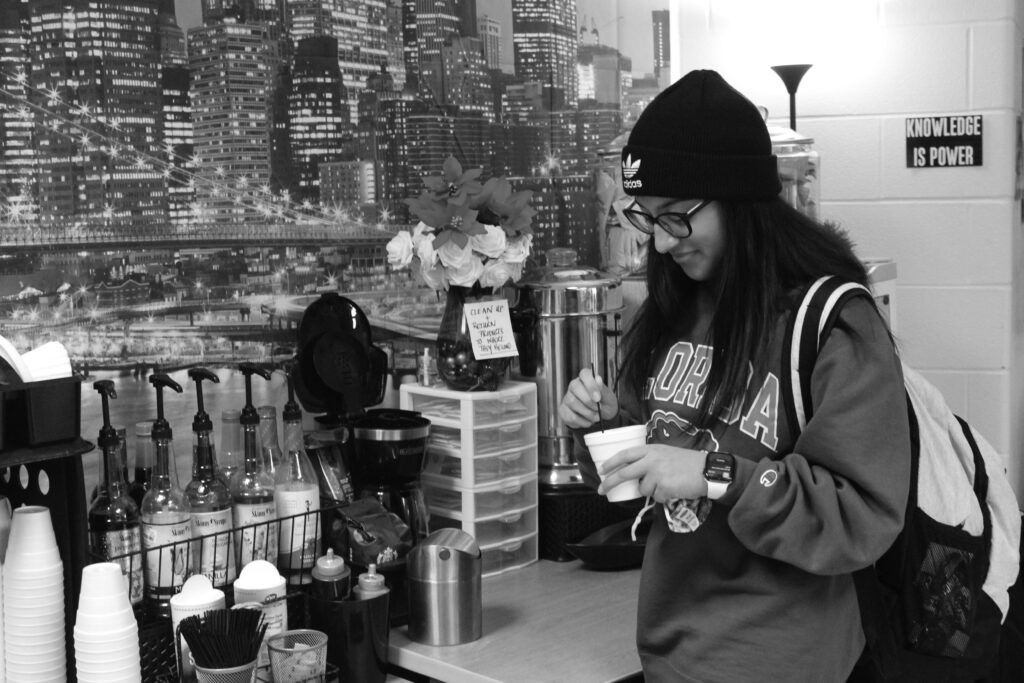Unconventional classroom arrangements foster positive student mindsets

Alisha Soni | The Chronicle
Teachers have begun to branch out of the traditional classroom standard.
Some MHS teachers have created more comfortable and collaborative learning environments by enhancing their classrooms. For English teacher, Nichole Wilson, the impacts of a decorated room, coffee bar with snacks, bean bag chairs, and flexible seating, are all key to creating a comfortable classroom. With the environment that Wilson has fostered, students get the opportunity to converse about ideas in an “out-of-the-box” manner.
“People will be open and vulnerable with ideas that they’re exploring when they can pick where they sit and with whom they speak with,” Wilson said. “I find that there’s better classroom management, better collaboration, and trust [that] develops throughout the year.”
Many of the components in Wilson’s classroom have been influenced by her upbringing. Growing up, Wilson and her family experienced financial difficulties, so she would often be sent to school without eating. Now as a teacher, she uses the opportunity to provide beverages or snacks for her students.
“[When] I hadn’t eaten when I went to school, the stress of not eating got in the way of what we were supposed to be doing, “ Wilson said. “But [now] I can provide it [for students].There’s an expense that comes out of my pocket and that’s not a problem at all. I’m happily investing time and money into that.”
Apart from the food available to students, Wilson’s intricately decorated room also connects back to her family. Despite financial hardships, Wilson’s family has always found the holidays to be a special time. They maintained the goal to be as decorative as possible, especially during the holidays. Wilson has carried that decorative mindset over to her classroom. Her classroom is always rotating different themes that purposefully tie into the specific unit being taught.
For students, the lengths that Wilson goes to create a pleasant, productive environment are greatly appreciated. Senior Anaya Joshi has made note of the different components of the classroom that affect her mood and create excitement to learn. Joshi said that apart from the inviting atmosphere and snack variety, Wilsons’ classroom serves as another motivator for students.
“She has a lot of hidden things around her room that pertain to a unit we were doing,” Joshi said. “I find that it gets you more motivated to see [the content] being worked into the real world. It’s really exciting to learn because she is so passionate about it.”
For English teacher Sarah Boselovic, her open-classroom concept and unconventional seating allow the classroom to follow a cafe-type environment. When Boselovic was a college student, she would often visit the cafe on campus to work on homework or other assignments. She noticed that other regulars there would gravitate toward the same spot each time. Many students would often sit in a location that best fits them, whether it was in a higher setting or a more comfortable spot. Now that she is a high school teacher, Boselovic aims to create a similar setting in her classroom. She said she tries to allow students to work in the environment that best suits their learning style.
Boselovic also takes into consideration the mental health aspect of the classroom. Boselovic said she believes the components of the learning environment are important in giving a student the chance to de-stress, especially from their other classes.
“Students generally feel calmer when they walk into the room,” Boselovic said. “It gives students a break in their day to not have the same monotonous type of classroom. It blends perfectly into my teaching style in general, which is [based on] student choice.”
From whiteboard tables to wobble chairs, – teacher Bud Strudhoff’s classroom also fits outside of a traditional learning environment. His diverse inventory consists of primarily hand-me-downs, perhaps from other teachers or his own home. Strudhoff said that being resourceful in finding classroom furniture has been important to his success in creating the classroom environment he wants.
“I’ve always been someone that just begs, borrows, and steals,” Strudhoff said. “I find a lot of stuff that I feel might work. It’s a lot of seeing ideas and other teachers’ classrooms that might work and then putting them into action.”
As more and more classrooms begin to take a comfortable approach, teachers view their classrooms as an opportunity for students to find comfort and motivation in their learning environments. According to Strudhoff, the effect of these classrooms are worth the time and effort it takes to create them.
“There are students that don’t feel comfortable in school just because of the rigidity that has been put in place in the American system of education,” said Strudhoff. “[My classroom] breaks a couple [of] barriers that create an atmosphere where they can hopefully learn a bit more.”
Photo by Alisha Soni
